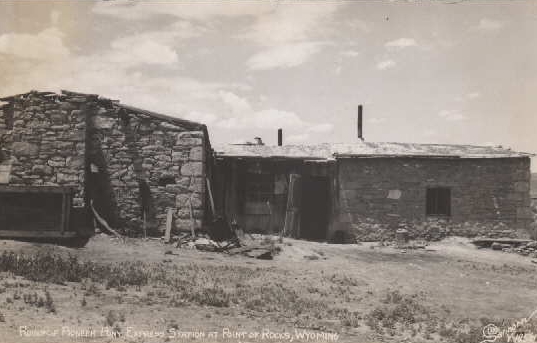
Point of Rocks Station
Point of Rocks Station, 22 miles northeast of Rock Springs and one-half
mile south of I-80, was built in 1861 or 1862 by Ben Holladay when Indian
depredations completed interdicted stage traffic on the Oregon Trail and forced
traffic further south. The move did not completely stop the problem and
the station was burned by the Indians at least once. In 1863, Overland ex-superintendent
Jack Slade held up the stage near here, killing 7 passengers, resulting in
the start of the cemetary (Drawing below right, C.M. Russell, Holdup of the Overland Stage).
The Railroad reached Point of Rocks in 1868, but 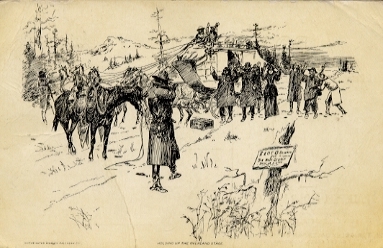 for many years the town remained an important junction point for stages and freighters
going to South Pass. In 1870, a stage left twice daily for South Pass City, a jolting
15 hour ride. With the decline of South Pass City and the mines, stage service
was discontinued in 1877, and the station became a private residence and a
school.
for many years the town remained an important junction point for stages and freighters
going to South Pass. In 1870, a stage left twice daily for South Pass City, a jolting
15 hour ride. With the decline of South Pass City and the mines, stage service
was discontinued in 1877, and the station became a private residence and a
school.
The last resident of the station was Jim McKee who reputedly was a
member of the Hole-in-the-Wall Gang. The Union Pacific, who by then had
acquired title to the building, attempted evict him, but was thwarted by
McKee's threats of bodily harm to the railroad representive. To deter other
visitors McKee posted a smallpox warning on the door. Today, the town is little more than an interchange on
I-80 with several trailer homes, a gas station and fireworks store.
Slade had served the Company as division superintendent, first in Julesburg,
replacing a French-Canadian,
Jules, after whom the town was named, and later in
the Rocky Ridge Division. Slade, when sober, was the perfect gentlemen, but
when besotted could be somewhat belligerent and was one not to readily forgive
slights. After Jules was dismissed, differences,
arose between the two which resulted
in each shooting and seriously wounding the other. Slade supposedly vowed that he
would have Jules' ears. Jules departed the area.
Months later after Slade was transferred to Rocky Ridge, the two met again with
Slade taking Jules prisoner, bringing him back to the Rocky Ridge Station, binding
him to a post in the station's cattle-yard and through the night taking shots and
nicking Jules. In the morning he finally dispatched Jules, cutting off his ears and
turning one in to a watch fob and the other into an 1860's version of a worry stone.
Jules, himself, may not have been so innocent. Eugene Ware, a young captain in the military serving
in the area, later wrote:
On the south side of the South Platte, perhaps about a mile east of
the mouth of "Lodgepole Creek," a Frenchman by the name of Jules had
started a trading-post. The place was a great Cheyenne crossing-ground
going north and south, and a frequent place of Cheyenne rendezvous.
It was also much used by the Sioux. The Cheyennes had a great liking
for the country on the South Platte at the mouth of Lodgepole, and had
had camps there for many years. Jules was said to be a half-breed
French-and-Indian trader, and to have established this post for the
purpose of trading with the Cheyenne Indians. It was said his name was
Jules Beni but everybody called him "Jules." He was a man of keen
native shrewdness, an exceedingly dangerous man, with a peppery,
fierce disposition. He had killed several persons, and had become
a great deal of a character in the country. A man who had known him
several years told me that Jules once killed two persons of local
celebrity, cut off their ears, dried them, and carried these four
ears in his pockets. That every once in a while he would take them
out and show them to somebody. They were great trophies, as he thought.
Mark Twain in Roughing It described, as a young lad, meeting Slade:
In due time we rattled up to a stage-station, and sat down to breakfast
with a half-savage, half-civilized company of armed and bearded mountaineers
, ranchmen and station employees. The most gentlemanly-appearing, quiet and affable
officer we had yet found along the road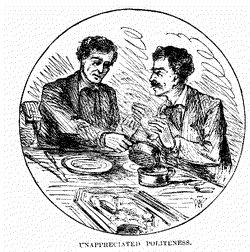 in the Overland Company's service was the
person who sat at the head of the table, at my elbow. Never youth stared and shivered
as I did when I heard them call him SLADE!
in the Overland Company's service was the
person who sat at the head of the table, at my elbow. Never youth stared and shivered
as I did when I heard them call him SLADE!
Here was romance, and I sitting face to face with it! -- looking upon it -- touching
it -- hobnobbing with it, as it were! Here, right by my side, was the actual ogre who,
in fights and brawls and various ways, had taken the lives of twenty-six
human beings, or all men lied about him! I suppose I was the proudest stripling
that ever traveled to see strange lands and wonderful people.
He was so friendly and so gentle-spoken that I warmed to him in spite of his
awful history. It was hardly possible to realize that this pleasant person
was the pitiless scourge of the outlaws, the raw-head-and-bloody-bones the
nursing mothers of the mountains terrified their children with.
Indeed, Slade insisted on personally refilling young Twain's empty coffee cup (copy of
original illustration above).
Ultimately, Slade's belligerency caught up with him. In Virginia City, Mont.,
the Committee on Vigilance, of which Slade was a member, took offense at his shooting
up the local saloons. When he refused service of a summons he was arrested. The
Committee, headed by one Paris S. Pfouts, the Town's founder,
first mayor and owner of the mercantile establishment, received advice from a corresponding
committee in Nevada that the appropriate punishment was hanging. Accordingly,
on March 10, 1864, 11 days following Pfouts' installation as first Master of
the Virginia City Masonic Lodge, the Committee, most of whom were Masons, inducted
Slade at the end of a rope into a different type of lodge. The ceremony, held in the
corral across from Pfouts' store, was
conducted by standing Slade on a packing case, with the rope tied to a corral post.
Slade's widow pickled his body in alcohol, kept it under her bed for several months,
before transporting it to Salt Lake City for burial.
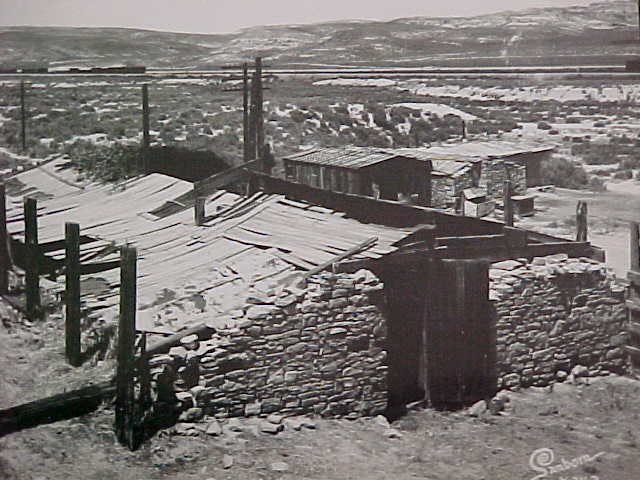
Point of Rocks Station
Another view of the stage station. Both this and
the view at the top of the page are by Sanborn Souvenir Co., Denver.
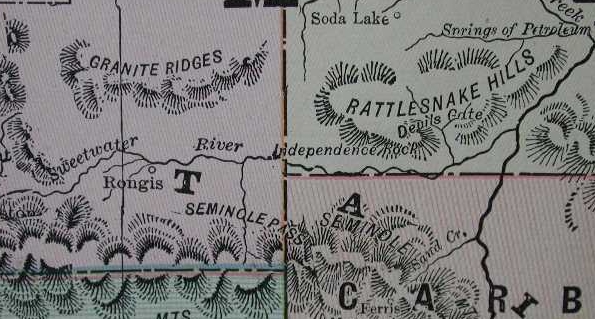
Portion 1891 Cram's Map of Wyoming
Rongis Stage Station, 1914, below left.
In map above, note location of the town of Rongis, photo of
stage station below. Note also spelling of Seminoe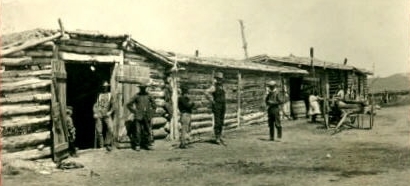 as "Seminole." The Seminoe Mountains and Reservoir
have nothing to do with the Seminole Indians of Florida and Oklahoma but are, instead,
named after Basil Cimineau LaJeunesse, a French-Louisianan guide who accompanied
each of the three Fremont expeditions including the 1843 expedition along the
Platte and Sweetwater. LaJeunesse was killed by Klamath Indians in May, 1846,
near Klamath Lake, Oregon. The application of the name to the area has been attributed to
Cimineau's brother, Charles LaJeunesse.
as "Seminole." The Seminoe Mountains and Reservoir
have nothing to do with the Seminole Indians of Florida and Oklahoma but are, instead,
named after Basil Cimineau LaJeunesse, a French-Louisianan guide who accompanied
each of the three Fremont expeditions including the 1843 expedition along the
Platte and Sweetwater. LaJeunesse was killed by Klamath Indians in May, 1846,
near Klamath Lake, Oregon. The application of the name to the area has been attributed to
Cimineau's brother, Charles LaJeunesse.
Additionally, note "Springs of Petroleum" in the vicinity of
present day Poison Spider Creek. A 1906 map shows Oil City in the area and continues to
use the spelling "Seminole". Although, as noted
elsewhere on this Website, the importance of coal was noted as early as the
Fremont Expeditions, the significance of petroleum was not generally recognized until
the 1880's. Joseph Riggs in the Scientific American Supplement, June 23, 1888, wrote of the significance of
the Territory's petroleum springs and lakes in an article entitled "The Wyoming Oil
Fields". Riggs, however, received greater attention for his predictions of
Omaha as a coal shipping point.
Rongis was located in Fremont County along the old Oregon
Trail on the Sweetwater River. for location see 1891 Map above. At the turn
of the century Rongis had a post office and a population of approximately 25.
Today the name survives as the name of a reservoir.
Other towns which consisted of little more than a post office whose names survive
as a reservoir include Campstool, pictured below right, at approximately 1909.
Campstool, adjacent to the old Burlington and Missouri River right of way to Sterling, Colo., was
located approximately 13 miles east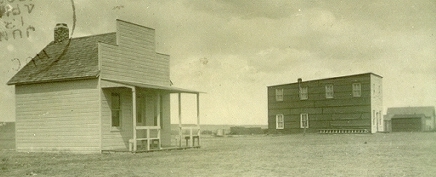 of Cheyenne on Campstool Road, just east of the
Campstool Reservoir. The town, on the southside of Crow Creek, was the location of a post office for several years at
the beginning of the century, and was named after the Camp Stool Ranch, founded shortly after
the Civil War. Although both North Platte, Neb. and Prescott, Ariz. each claim to have had
the first rodeo, in actuality, Deer Trail, Colo., has a better claim. Riders from
the Camp Stool, Mill Iron and Hashknife Ranches competed in a bronco riding contest on July 4, 1869. The
contest was won by a Mill Iron rider, Emilnie Gardenshire, riding a Hashknife bronco named
Montana Blizzard. Gardenshire won a suit of clothes donated by a Denver dry goods store and the
title "Champion Bronco Buster of the Plains." of Cheyenne on Campstool Road, just east of the
Campstool Reservoir. The town, on the southside of Crow Creek, was the location of a post office for several years at
the beginning of the century, and was named after the Camp Stool Ranch, founded shortly after
the Civil War. Although both North Platte, Neb. and Prescott, Ariz. each claim to have had
the first rodeo, in actuality, Deer Trail, Colo., has a better claim. Riders from
the Camp Stool, Mill Iron and Hashknife Ranches competed in a bronco riding contest on July 4, 1869. The
contest was won by a Mill Iron rider, Emilnie Gardenshire, riding a Hashknife bronco named
Montana Blizzard. Gardenshire won a suit of clothes donated by a Denver dry goods store and the
title "Champion Bronco Buster of the Plains."
More ghost towns on next page.
|